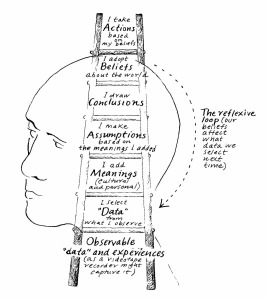This is a post I wrote for the Vision Room in September of this year.
I say a lot of things I don’t actually do. I don’t intend to lie, or even drop the ball. It is just that I don’t seem to be able to execute consistently what I envision in the future. The gap between what we say and what we do can be hard to acknowledge. In fact, I used to really beat myself up for this, but as it turns out, I am not alone in this gap between what I espouse and what I actually produce. Even Paul in Romans points to this gap: “For what I am doing, I do not understand; for I am not practicing what I would like to do, but I am doing the very thing I hate.” (Rom. 7:15) Not living according to our aspirational values is part of the human condition, but not all of us address this dissidence in a way that results in reducing the gap.
I first became aware of this as a theory when reading a book by Chris Argyris (Strategy, Change, and Defensive Routines). At its root, the idea is that we all have two theories in our head at any one time:
1. Espoused Theory
The worldview and values people believe their behavior is based on.
2. Theory-in-Use (Produced in Action)
The worldview and values implied by their behavior, or the maps they use to take action.
At times, these two theories are perfectly aligned and our behavior is exactly what we want it to be, and exactly what we said it would be. Of course that builds credibility and trust in our relationships and we should strive for this all the time. Other times, the distance between our espoused and lived-out values can be visible and even painful. How do we, in those times, create more alignment between our aspirations and our actions?
For Ourselves
When we notice this misalignment, consider it a great learning opportunity. Having the self-awareness to recognize the gap is a critical first step. Rather than beating yourself up over the gap, I suggest you respond carefully:
- Fix It. Can you correct this now, or is it too late? If there is still a chance to ‘do the right thing’, then do that immediately. As you do, pay special attention to what is the most difficult about it. That will provide insight to the inner struggle you have to resolve.
- Inspect your Values. Are your espoused values really what you want? If so, then dig deep and do more of that. What was most difficult about doing the right thing in the first place? Work with a friend or mentor to talk through that challenge.
- Communicate Carefully. Once you are more clear about your actual values and beliefs (not just aspirations), get very good at communicating precisely what you value and where you are on that journey. I believe my diet is the number one factor in my physical health, and I believe we all have responsibility for our own health. However, I am overweight and eat too much of the wrong stuff and too little of the right stuff. I now have to add a caveat to that belief: “and I am really struggling to implement that consistently.” Open acknowledgment of the struggle creates credibility with others and an environment where people may feel safe to be more transparent themselves.
For Others
As leaders in our organizations, sometimes we are more aware of our co-workers’ inconsistency than our own, especially when we are in the supervisor role. How do we deal with that?
- Stop Assuming the Worst. We often jump right to a character flaw in that person. “He must have lied during the interview.” “I guess he doesn’t really care as much as he said.” Give them a break and assume they had the best of intentions and just have a gap between what they espoused and what they produced. It is OK for you, right? Then make it OK for them too.
- Remember Your Purpose. As a leader/mentor/supervisor your primary job is to develop the people around you. Getting the work at hand done is important, but should be secondary to building the capacity of the people who do the work. We all need people in our lives to help us identify these disconnects — take the time to have the conversation. “Elizabeth, I know you value treating others with respect, and yesterday you interrupted Shannon several times. Help me understand what was going on there.”
- Be Precise. Be very careful to describe the problem you are trying to solve. There are usually two problems and people often get them mixed up. One is the specific behavior that created the concern (the immediate problem). The other is the gap between espoused and produced beliefs (the more important problem). Separate the conversation to ensure you are only working one problem at a time. Why Elizabeth was acting outside of her values in that moment and apologizing to Shannon are two different things and should be treated separately.
Your Next Move
For yourself, think about the past week — is there any situation where your behavior did not match your espoused beliefs? Go address it in your own heart and then with the other person immediately.
For others, have you judged someone too harshly? Go apologize and reengage them to give the benefit of the doubt. Be prepared for hesitancy and defensiveness in that person. That is to be expected and is simply part of the process.



